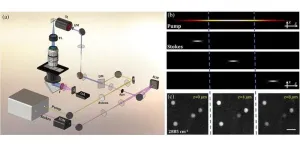(Press-News.org) Roughly a third of the climate cooling that forests achieve by removing carbon dioxide (CO2) from the atmosphere is offset through changes to atmospheric composition and decreased surface reflectivity, researchers report. The findings suggest that the benefits of wide-scale forestation efforts may be overestimated and do not represent a single solution for addressing climate change. They also highlight the urgency of simultaneously focusing on emissions reductions. Planting trees has been widely promoted as a nature-based solution to remove anthropogenic CO2 from the atmosphere to help mitigate ongoing climate warming. However, wide-scale forest expansion may drive feedbacks within the Earth system that lead to warming. For example, changes to atmospheric composition (via the release of biogenic volatile organic compounds that affect greenhouse gasses and organic aerosols) and decreased surface albedo could offset the cooling effects of atmospheric CO2 removal (CDR) by forestation. However, the effects and their impact on climate remain relatively unexplored. Using two state-of-the-art climate models – UKESEM1 and CESM2 – James Weber and colleagues compared extensive global forestation scenarios and evaluated their impact on climate and the climatic benefit from CDR. According to the findings, when forestation is simulated under a scenario with few other climate change mitigation strategies, the higher volatile organic compound emissions from vegetation increase greenhouse gasses ozone and methane in the atmosphere. This, combined with changes to surface albedo and light-scattering organic aerosols, results in a net warming effect, which offsets ~31% of the cooling benefit from CDR. However, Weber et al. show that tree planting still is an important climate change mitigation strategy to pursue when combined with greenhouse gas emission reductions. In a related Perspective, Garry Hayman discusses the study in greater detail.
END
Chemistry and albedo feedbacks offset forestation’s net climate benefits
2024-02-22
ELSE PRESS RELEASES FROM THIS DATE:
Snakes do it faster, better: How a group of scaly, legless lizards hit the evolutionary jackpot
2024-02-22
More than 100 million years ago, the ancestors of the first snakes were small lizards that lived alongside other small, nondescript lizards in the shadow of the dinosaurs.
Then, in a burst of innovation in form and function, the ancestors of snakes evolved legless bodies that could slither across the ground, highly sophisticated chemical detection systems to find and track prey, and flexible skulls that enabled them to swallow large animals.
Those changes set the stage for the spectacular diversification of snakes over the past 66 million years, allowing them to quickly exploit new opportunities ...
Side effects of wide scale forestation could reduce carbon removal benefits by up to a third
2024-02-22
The side effects of large-scale forestation initiatives could reduce the CO2 removal benefits by up to a third
Researchers at the University of Sheffield used computer models, which simulate the land, ocean and atmosphere, to investigate the impact of forestation under future climate scenarios
While forestation increases atmospheric CO2 removal, it also changes atmospheric composition and darkens the land surface, reducing its potential to tackle climate change
Combining forestation with other climate mitigation ...
Yale chemists synthesize unique anticancer molecules using novel approach
2024-02-22
New Haven, Conn. — Nearly 30 years ago, scientists discovered a unique class of anticancer molecules in a family of bryozoans, a phylum of marine invertebrates found in tropical waters.
The chemical structures of these molecules, which consist of a dense, highly complex knot of oxidized rings and nitrogen atoms, has attracted the interest of organic chemists worldwide, who aimed to recreate these structures from scratch in the laboratory. However, despite considerable effort, it has remained an elusive task. Until now, that is.
A team of Yale chemists, writing in the journal Science, ...
Maynooth University partners in study published in Science that finds evidence of elusive neutron star
2024-02-22
A new study, published in Science and co-authored by Dr Patrick Kavanagh of Maynooth University’s Department of Experimental Physics in Ireland, has provided the first conclusive evidence for the presence of the elusive neutron star produced in the supernova SN 1987A.
Supernovae are the spectacular end result of the collapse of stars more massive than eight to ten times the mass of the sun. Besides being the main sources of chemical elements such as the carbon, oxygen, silicon, and iron that make life possible, they are also responsible for creating the ...
James Webb telescope detects traces of neutron star in iconic supernova
2024-02-22
Scientists can finally show that a neutron star formed from our most well-studied supernova, SN 1987A. The breakthrough was made possible thanks to the James Webb telescope.
Supernovae are the spectacular end result of the collapse of stars more massive than 8-10 times the mass of the sun. Besides being the main sources of chemical elements such as carbon, oxygen, silicon, and iron that make life possible, they are also responsible for creating the most exotic objects in the universe, neutron stars and black holes.
In 1987, supernova 1987A (SN 1987A) ...
Enhanced 3D chemical imaging with phase-modulation
2024-02-22
Understanding complex biological and biomedical systems is greatly aided by 3D imaging, which provides much more detailed information than traditional two-dimensional methods. However, live cell and tissue imaging remain challenging due to factors like limited imaging speed and significant scattering in turbid environments.
In this context, multimodal microscopy techniques are notable. Specifically, nonlinear techniques like CRS (coherent Raman scattering) use optical vibrational spectroscopy, providing precise chemical imaging in tissues and cells in a label-free way. Furthermore, stimulated Raman scattering (SRS) ...
Researchers harness 2D magnetic materials for energy-efficient computing
2024-02-22
CAMBRIDGE, MA — Experimental computer memories and processors built from magnetic materials use far less energy than traditional silicon-based devices. Two-dimensional magnetic materials, composed of layers that are only a few atoms thick, have incredible properties that could allow magnetic-based devices to achieve unprecedented speed, efficiency, and scalability.
While many hurdles must be overcome until these so-called van der Waals magnetic materials can be integrated into functioning computers, MIT researchers took an important step in this direction by demonstrating precise control of a van der ...
Empowering autistic teens: New clinician advice for navigating chronic pain
2024-02-22
When you’re an autistic teenager living with chronic pain, getting treatment for your pain can be a challenging experience. That’s according to a group of young people who’ve spoken to Dr. Abbie Jordan of the Department of Psychology and Centre for Pain Research at The University of Bath about their experiences. Teenagers mention sensory issues, a lack of autism awareness among staff, or feeling “doubly different” compared to their peers, making receiving “one-size-fits-all” psychologically focused treatment for their chronic pain ...
Climate change linked to rise in mental distress among teens, according to Drexel study
2024-02-22
Worsening human-induced climate change may have effects beyond the widely reported rising sea levels, higher temperatures, and impacts on food supply and migration – and may also extend to influencing mental distress among high schoolers in the United States.
According to a representative survey of 38,616 high school students from 22 public school districts in 14 U.S. states, the quarter of those adolescents who had experienced the highest number of days in a climate disaster within the past two years and the past five years – such as hurricanes, floods, tornadoes, droughts, and wildfire – had 20% higher odds of developing mental ...
Combination of group competition and repeated interactions promotes cooperation
2024-02-22
One of the great unresolved mysteries of human evolution is how pro-social, cooperative behavior could have evolved. What led to the establishment of a behavior that prioritizes the benefit of the community over that of the individual in a world where materially successful individuals reproduce, and others slowly perish?
The prevailing theory suggests that this occurred due to repeated interactions. Over generations, humans learned that cooperative behavior pays off in the long run. People collaborate because they anticipate interacting with the same individuals ...



